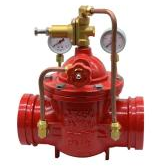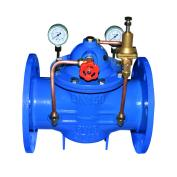Pressure Reducing Valve Supply & Manufacture
What is pressure reducing valves?
Pressure Reducing Valves are designed to decrease the incoming high pressure of water into a lower and safer pressure. They are normally installed on the main water line next to the shut-off valve. A reducing valve can also be set to any desired downstream pressure within its design limits. Once the valve is set, the reduced pressure will be maintained despite the changes in the supply pressure and system load variations.
Advantages of pressure reducing valves:
- Reduces risk of water leaks.
- Prevents “screaming” noise caused by high flow velocities.
- Ensures reliable and stable pressure for household water systems.
- Automatically conserves water when used in high pressure areas.
- Reduces the energy required to heat water for showers, dishwashers, washing machines, etc.
- Protects water-using appliances and fixtures by reducing the amount of water pressure on them.
Different Types of Pressure Reducing Valves-According to connection method

Grooved Pressure Reducing Valves
Grooved pressure reducing valve is a special type of pressure reducing valve, which is characterized by the use of grooved clamp connection, making the connection process relatively simple, this connection not only simplifies the installation process, but also improves the reliability and sealing of the system. Grooved pressure reducing valves are commonly used in domestic water supply, fire-fighting water supply and other industrial water supply systems.

Flange Pressure Reducing Valves
Pressure reducing valves with flange connection are mainly used to reduce the inlet pressure to the desired outlet pressure and keep the outlet pressure stable. It relies on the medium’s own energy so that the outlet pressure can be automatically stabilized without the need for an external energy source. This makes flanged pressure reducing valves widely applicable in various industrial and commercial applications.
Specifications:
- Material:Ductile iron/ Cast iron
- Size:DN15- DN150
- Working pressure: PN10-PN25
- Working temperature:0°C-80°C
- Connection: flange, groove
- Standard: BS, DIN, ANS, ISO.
Production Process:

Fields of Application
Air conditioning system
Used to control the flow of air conditioning pumps and piping systems to regulate the temperature of the air conditioning system
Water treatment
Effectively control and regulate water pipe flow to ensure appropriate water quality.
Power system
Control and regulate the flow and pressure of water flow in the power system to ensure the normal operation of the power system.
Heating system
Control the flow of the hot water piping system to adjust the temperature of the heating system to meet the temperature requirements in the house.
Frequently asked Questions and Answers
Reason: The main valve spring may be broken, bent, or deformed; the damping orifice may be clogged; the pressure reducing valve may not be supplied with fluid.
Solution: Repair or replace main valve parts and spring, filter or replace oil. Check the oil circuit and eliminate the fault.
Reason: Incorrect use; clogged or obstructed drain passage. Failure of the main valve.
Solution: Repair and replace parts, check oil quality and replace fluid.
Reason: The main valve spring is too weak, deformed or pinched on the main valve spool, resulting in difficulty in the movement of the spool; the small damping hole is clogged or poorly ventilated.
Solution: Repair or replace the parts to ensure that the geometric accuracy of the main valve spool and the valve body are matched, replace or adjust the main valve spring, and clean the damping hole.
